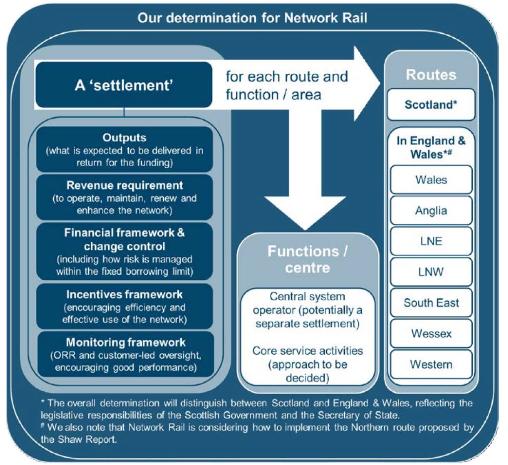This is the first in a series of updates on the 2018 periodic review of Network Rail, also known as PR18. This update summarises the Initial Consultation from the Office of Rail and Road (ORR) published in May 2016.
Purpose and aim of PR18
The 2018 periodic review will determine:
- Network Rail's outputs and funding in control period 6 (CP6) which is expected to be another 5 year period, running from 1 April 2019 to 31 March 2024
- Track access and station access charges
- The wider 'regulatory framework', including Network Rail's financial framework and the incentives to encourage it and train operators to perform well.
The proposed aim of the review is to support "a more efficient, safer and better-used railway, delivering value for passengers, freight customers and taxpayers in CP6 and beyond". With limited resources, the ORR is concentrating on efficiency and getting most value out of the existing network, rather than any ambitious new projects that are not already in the pipeline.
Approach
The ORR has in this initial consultation set out its high-level approach to delivering its aims and objectives for the review. There are five aspects:
- Focus on regulating at a route-level
- Improve the regulation of system operation
- Refine the framework for outputs and how these are monitored
- Increase transparency around costs and improve incentives
- Support new ways to treat enhancements.
Most notably, the ORR proposes to make a number of changes to how it regulates Network Rail which, taken together, mean that this review is likely to be significantly different from previous ones.
Route level regulation
Network Rail is now organised around eight route businesses, supported by a system operator function and centrally-based business units providing services (HR, major projects, procurement) to the routes. This gives the ORR the opportunity to regulate Network Rail at a route level. allowing them to put greater reliance on comparison between the route businesses. There will be a working paper on route level regulation which will look at this in more detail.
System operation regulation
For CP6, the ORR think their regulation of Network Rail should involve a tailored and more focused approach to the system operator activities that Network Rail undertakes centrally. This could involve a combination of performance measures or outputs; financial incentives, costs information; and greater transparency about performance. The ORR will shortly publish two working papers on how their regulation in this area might develop, along with a conclusions note from their August 2015 consultation on system operation.
Outputs framework
The outputs framework encourages Network Rail to improve outcomes for passengers and freight customers and provides for transparent oversight of its performance in key areas including efficiency and maintenance and renewals. The ORR will review the outputs framework and change it to reflect the greater focus on Network Rail's routes and system operator role. It is likely to increase the involvement of train operators and other stakeholders in setting outputs and improve how passenger experience is reflected in output measures and monitoring. The ORR is looking at monitoring this via route scorecards and increased transparency. There will be a subsequent working paper on outputs setting out the ORR's initial thinking.
Costs transparency and incentives
This covers access charges and the incentives around performance and possessions. The ORR note that the potential for governments to channel more funding through train operators (rather than through direct grants to Network Rail) and to increase franchised operators' exposure to Network Rail's costs provides the potential for a range of improvements in how charges affect behaviours.
Notably, the ORR is considering whether some open-access operators should make a greater contribution to network costs, as at the moment they only pay short-run variable charges, not fixed track access charges. The ORR's proposals on the structure of charges in late 2016 will consider this further.
New ways to treat enhancements
The DfT has asked the ORR to explore the implications of taking the funding of enhancements outside of a periodic review. There are potential benefits from aligning major enhancement, franchising and rolling stock decisions rather than having a five-year specification of enhancements.
Questions that need considering include: what role should the routes have in the planning process; who commits to projects that are funding outside PR18; how will projects be funded (e.g. grant funding instead of the current debt funding)?
The ORR will provide more detail in their forthcoming working paper on enhancements.
Framework for the review
The ORR proposes a single determination for Network Rail as a whole, but made up of separate settlements – one for each route plus possibly one for its system operator functions, as set out in this diagram:

The consultation goes into more detail under each of the headings under 'settlement' above but some points that spring out are:
- Outputs will be set at a route level and could include the ORR specifying the minimum number of key output areas needed to assure network capability and enable route comparisons
- Given Network Rail's recent difficulties and the fact that it is a public sector organisation, the ORR will need to decide whether to base its efficiency assumptions on what a fully efficient company might be expected to achieve, or reflect a realistic level of challenge for Network Rail might reasonably be expected to achieve in practice
- The ORR will need to make route-level assumptions on income which will include, at a route level: access charges income; Schedule 4 and 8 receipts/payments; property and other income; any network grant
- Network Rail's borrowing limits and the process for agreeing them is the most important financial issue affecting it in CP6 and all stakeholders need to understand how the process for setting the borrowing limits affects Network Rail's planning and the ORR's determination
- Routes need to have strong incentives to outperform their regulatory settlements and to grown their income. This could include the use of scorecards. Network Rail will need flexibility to reallocate money across the routes to protect them from unexpected costs
- The Schedule 8 contractual performance regime may need to change and the ORR will consulted on proposals for the incentives framework later in 2016.
What happens next?
This initial consultation is open until 10 August 2016. There are three main phases of PR18:
- Setting the framework: May 2016 to late spring 2017
- Detailed development, review and ORR determination: late spring 2017 to October 201
- Implementation: November 2018 to March 2019.
There is a draft timetable on the ORR website which they will keep updated as the review progresses.
This includes some key dates when we expect further working papers and consultations to be published:
Late May/early June 2016 – working papers on:
- implementing route-level regulation (working paper 1 ‘WP1’)
- potential issues and opportunities in system operation (WP2)
- initial views on the regulatory framework for Network Rail’s system operator function (WP3)
- our thoughts on the outputs framework for CP6 (WP4)
- options for the framework for enhancements in CP6 (WP5).
Late 2016 – ORR's conclusions on its initial consultation from May 2016 and new consultation on incentives and charges, financial framework issues and further issues relating to the overall PR18 framework.



